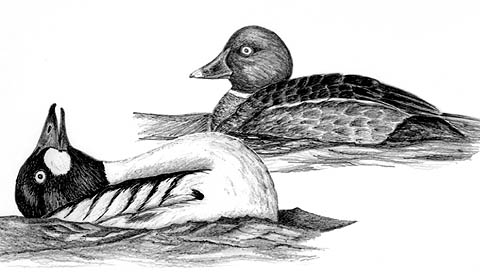
Dear Bird Folks,
Last week I saw a group of ducks feeding on the Town Cove in Orleans. At first I thought they were Buffleheads, but my book said that they were “Common Goldeneyes.” I had never seen this bird before. What caught my eye was that one bird seemed to be choking. It’s head was surging back and fourth as if it was trying to dislodge a piece of food. Then suddenly, several other bird were doing the same thing. I’m sure they all couldn’t have been choking at the same time. What was going on?
-Billy, Orleans
Be Careful Billy,
Although it is rare, ducks do occasionally choke on their food. If that happens, it’s okay to try the Heimlich, but don’t try using mouth to beak. First of all, the duck’s fish breath is nasty and, secondly, you never know who is walking around with a camera. You would hate to have your picture on the cover of the National Enquirer, while you are planting a big one on the lips of a duck. That would take too much explaining.
Good for you Billy for noticing that the Goldeneyes weren’t Buffleheads. Goldeneyes are common ducks around here in the winter, but from a distance they do look like the even more common Buffleheads. They both are small diving ducks, with white bodies and black backs. They both have dark heads with large white patches. But the Bufflehead’s white patch is quite large and is on the back half of the head, while the goldeneye’s smaller white patch is just below the eye, near the bill.
The goldeneye has two other distinct field characteristics. One is the sound of their wings. Flying with nine wing beats per second, the goldeneye creates a whistling sound as it flies. Migrating birds were given the colloquial name of “Whistler.” Not to change the subject, but wouldn’t it be nice if they came up with a colloquial name for “colloquial”? It hurts just trying to say it. The other key mark on this duck is, of course, its eye. It does indeed have a golden eye that can be seen from a fair distance. However, in recent years, due to cost cutting, the bird’s eye has gone from solid gold to a much cheaper gold plating.
Now that we have that out of the way, we can get on to the reason why your ducks were choking. Most songbirds perform their courtship rituals on their breeding grounds. But many ducks start displaying in the winter, well south of their nest sites. What you saw Billy was a flock of goldeneye males trying to impress the nearby hens. Although they may have been emotionally choked up, they definitely weren’t choking. The goldeneye’s most common display is for the drakes to lunge forward and then to flip their heads way over their backs, to their tails. A move that would make most yoga gurus jealous.
Goldeneyes are diving ducks and when they aren’t performing for a mate, they are diving for small crabs, fish and muscles. Which brings us to another odd thing about Goldeneyes. Fish and muscles are eaten in the winter, but are avoided in the summer when the bird’s diet switches to aquatic insects. Lakes with fish in them are actually avoided in summer. I’m not saying that the birds suddenly develop a form of fish-phobia, but they do seek out lakes that are void of fish. Lakes that don’t have fish, have more aquatic insects, the bird’s favorite summer food.
Fish-free lakes not only provide food but are safer for the ducks. Many young ducklings are consumed each year by hungry bass or pike. Competition is so fierce for these lakes that often two female goldeneyes, each with a new family, will fight for it. The loser will be driven off the lake and the winner will end up with both broods of ducklings. What, the winner gets more kids? Ha, I’d lose on purpose.
Odd as it may seem, our dirty industries have benefited these ducks. The dreaded acid rain has assisted Common Goldeneyes by killing the fish in thousands of northern lakes, thus creating new breeding habitat for them. The acid rain may have also helped these ducks by killing millions of trees. Like Wood Ducks, goldeneyes build their nests inside tree cavities. Dead, rotting trees are a welcome sight for these ducks when they return north.
Goldeneyes are hardy birds and begin to migrate north at the end of March. When they head out they usually have a partner with them. Their weird “choking” courtship seems to do a very good job at attracting a mate. And you should know Billy, it attracted you.